Mountain Meadow Tales – Vibrant Flowers
By John Palka — Posted September 25, 2016
The mountains of the American West are justly famous for their alpine flower meadows, none more so than the Colorado Rockies and the Washington Cascades.
The growing season at high elevations, from 5,000 feet up, is extremely short. Many years the winter snows don’t melt off until July, and freezing temperatures start returning in September. During the brief summer period the meadows produce a succession of brilliant flowers.
As soon as the snows retreat, the yellow glacier and white avalanche lilies appear.
By mid-summer, the meadows are a riot of color. Among many plants calling out to pollinators are the brilliant scarlet to lavender Indian paintbrush (Castilleja), the blue arctic lupine (Lupinus arcticus), the Sitka valerian (Valeriana sitchensis), and bear grass (Xerophyllum tenax).
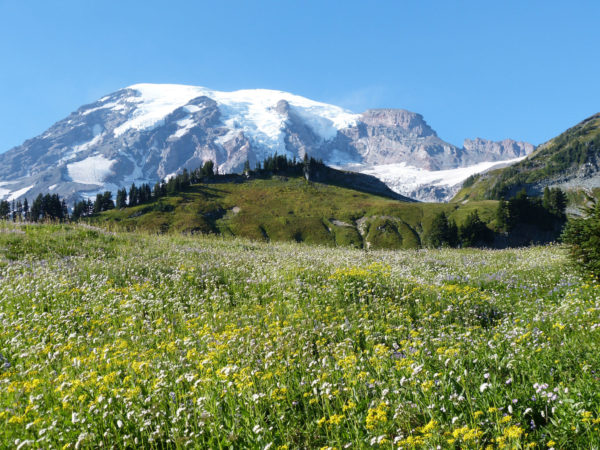
Subalpine meadow, mid-summer. White flowers mostly Sitka valerian (Valeriana sitchensis, Family Valerianaceae); yellow flowers unidentified members of the aster family (Asteraceae). Skyline Loop Trail, Mt. Rainier.
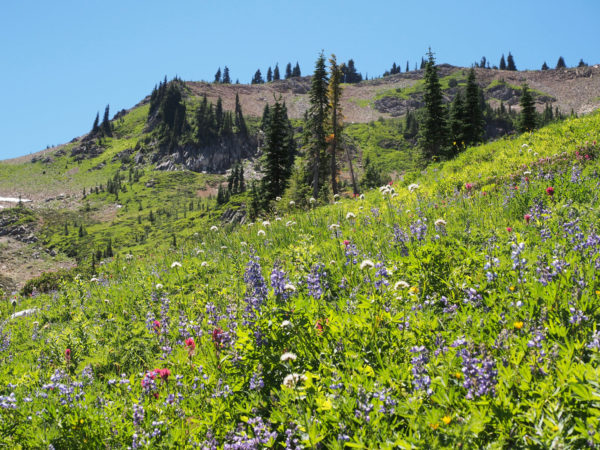
Another mid-summer meadow. White flowers Sitka valerian (Valeriana sitchensis; blue flowers subalpine lupine (Lupinus latifolius); red flowers Indian paintbrush (Castilleja sp.). Naches Peak Trail, Mt. Rainier.
Late in the summer the beautiful pearly everlasting abounds on the drier slopes, attracting numbers of butterflies. Walking the meadows is a thrill, as the whole area reverberates with brilliant color and urgent life
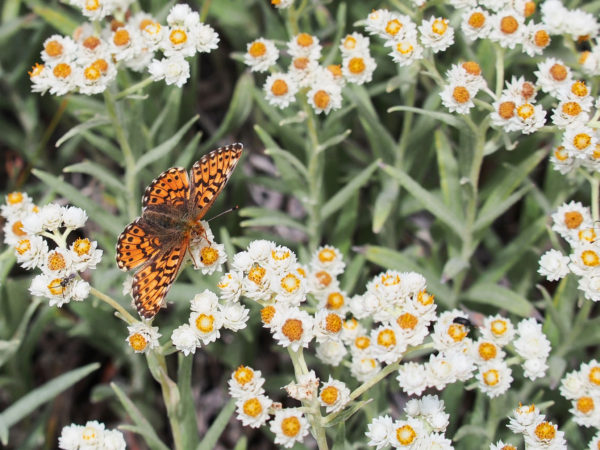
Pearly everlasting (Anaphalis margaritacea, Family Asteraceae) with visiting fritillary butterfly (Speyeria). Olympic Mountains.
Why do meadow plants invest so much of the energy they have available for growth into producing showy flowers? The flowers are an essential part of their sex life, and sex is a central part of the evolution of life on Earth. The males of many animals are showy and, during mating season, aggressive. They invest vast energy in making themselves attractive to females. Flowers and their pollinators work together to accomplish the same end.
An essential step in the sexual reproduction of flowering plants is the transfer of pollen (containing the sperm cells) to the stigma (providing a pathway to the eggs). Some plants are self-pollinated, but this means abandoning most of the genetic advantages that sexual reproduction provides. Cross-pollination ensures the mixing of gene variants carried by the two parents. New and unpredictable gene combinations arise at a stroke, and the resulting variation is part of what enables the new generation to respond to environmental pressures in a highly flexible way. Most flowering plants have evolved effective mechanisms for avoiding self-pollination and promoting cross-pollination.
Sometimes wind or even water is the carrier of the pollen, but the showy flowers are showy specifically so that they can attract animal pollinators, including hummingbirds, bees and bumblebees, butterflies, flies, and beetles. These roving messengers of sex are attracted to both the colors and the odors of flowers, and these are signals that the flowers produce in abundance. What do the pollinators get for being attracted? Nectar and pollen, essential sources of energy for maintaining their own life processes, and sometimes also the opportunity to meet up with their own sexual partners. It is a great example of co-evolution, the matching of attributes in diverse organisms in ways that benefit them both.
Let me illustrate this with a spectacular meadow flower. The exotic-looking elephant’s head has a special relationship with bumblebees. Sometimes pollination is carried out by insects foraging for nectar, like the fritillary butterfly visiting the pearly everlasting in the photograph above. Pollen sticks to the insect’s body surfaces and is carried from one flower to another as the insect forages for the nectar, thus carrying out the cross-pollination that the flowers require. Many insects, however, including bees and bumblebees, forage for pollen as much as they do for nectar. Pollen is the principal source of protein for themselves and their brood, and they collect it in special pollen baskets on their legs.
Elephant’s head does not even produce nectar, and it hides its pollen deep within each flower. The bumblebee alights on the flower, tucks its head deep into the flower’s intricate crevices, holds on with its mandibles, presses up against the long “trunk” that gives the flower its name, and buzzes. The vibration it produces with its wing muscles, quite different from the contractions it uses to fly, shakes loose a tiny cloud of pollen that settles on the hairs covering the bumblebee’s body. Once the bumblebee retreats from the flower, it uses its front legs to scrape the pollen into baskets on its hind legs. Enough, however, remains on the body surface to effect the pollination of the next elephant’s head flower the bumblebee visits.
This remarkable buzzing behavior was first observed in 1959 by a biologist working in New Guinea. He heard a rather loud buzzing sound that he could not identify, and ultimately traced it to a bumblebee buzzing a flower. Since then, buzz pollination has been noted among many bee and plant species worldwide. In our region, too, the highly complex flower of elephant’s head is not the only flower buzzed by foraging bumblebees. Among other species in which this behavior has co-evolved is the shooting star, commonly seen in many habitats in the Northwest including alpine meadows.
How do we discover stories like this? Through the patient observations of generations of biologists, who sit on the ground and watch, sometimes for hundreds of hours. They document the visitors coming to particular flowers, trap the pollinating insects so they can be identified, examine the pollen on the insects’ bodies and in their pollen baskets to see what other species of flowers they might have visited, and—in the case of the bumblebees dislodging clouds of pollen from elephant’s head flowers—take high-speed movies of the whole process so it can be better understood.
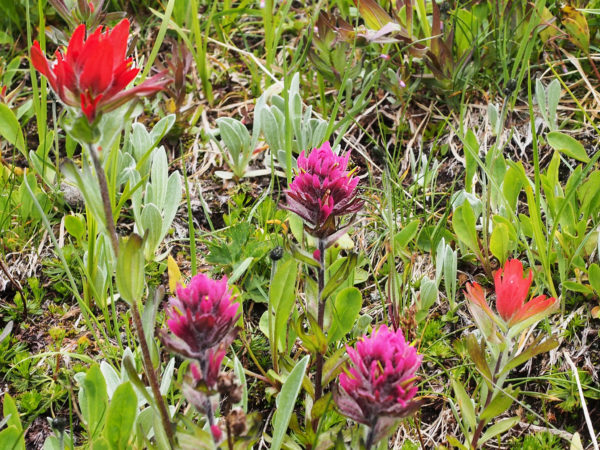
Indian paintbrush (Castilleja, probably parviflora (lavender) and miniata (red), Family Orobanchaceae). Hart’s Pass, North Cascades.
Pictured above is another example of how biologists uncover the secrets of flowers. Four species of Indian paintbrush (Castilleja) occur in Mt. Rainier National Park, including these two that I photographed in the North Cascades. Because of the substantial color variation within a single species, these are not easy to tell apart, but a botanist with a hand lens can do so reliably. The questions are these: Who are the pollinators of these four species? And do different species have different pollinators? Colors at the red end of the spectrum often attract hummingbirds, and if the flowers have a tubular shape that could be probed by the bird’s beak and tongue, hummingbird pollination becomes an excellent possibility. One of these species (Castilleja cryptantha) is yellow, not red. Does it have a different biology? Parenthetically, the colors in paintbrush are not actually in the plant’s flowers. Its flowers are inconspicuous and mostly yellow-green. Each flower is, however, enfolded in a brightly-colored structure called a bract, and this is what attracts pollinators. A somewhat similar situation prevails in Christmas poinsettias—the bright red that catches our eye is the color of their bracts.
A study on the Indian paintbrush of Mt. Rainier National Park, based on 220 hours of careful observation, reported the following outcomes. The two species pictured above were visited exclusively by rufous hummingbirds (Selasphorus rufus). A third red species (Castilleja oreopola) was visited both by hummingbirds and by three species of bumblebees. However, the bumblebees were too small to be effective in transferring pollen from one flower to the next, so they made visits without repaying the paintbrush with pollination. No visits by any pollinator were recorded for the yellow species, C. cryptantha.
A simple experiment provided an added dimension to the story. When mesh cages were placed around several of the paintbrush plants to exclude any possible pollinators, the seed set fell almost to zero for the red flowers visited by hummingbirds. Clearly, hummingbirds sucking up nectar from the inner recesses of one red-bracted flower and then visiting another was an essential and effective step in pollination. In contrast, the seed set in the caged yellow-bracted flowers exceeded 90% of the uncaged value. The combined data—no visitation by pollinators, and seed set unaffected by pollinator exclusion—provide compelling evidence that the yellow-flowered species neither receives nor requires pollinators. Rather, it relies on self-pollination and has abandoned the genetic advantages of full-fledged sexual reproduction. It is a rare species and endemic to Mt. Rainier, occurring nowhere else in the world. Whether this rather precarious status is related to its habit of self-fertilization is not known.
There is yet more to this story. Rufous hummingbirds are amazing creatures. They make an annual migration that takes them northward from their wintering range in Mexico, along the west coast of North America all the way to southeastern Alaska where they breed, and then back down through the Rockies until they return to Mexico – a distance of 6,000 miles. They know their route well. Banding studies even show individuals returning to hummingbird feeders in specific urban gardens along the way. As they migrate, they feed on the nectar of a variety of red, tubular flowers including the Indian paintbrush of Mt. Rainier and the North Cascades that you see in these photographs. These hummingbirds are the dominant pollinators of the paintbrush in our high mountains. In this sense our flower meadows are dependent on a web of life that stretches thousands of miles north and south, and on the integrity of hummingbird habitat along the way!
When we walk around a meadow in bloom, we are seeing life in action. The flowers are advertising their presence, the pollinators are surveying the territory for potential sources of food, and the sensory signals generated by the flowers match the sensory capabilities and behavioral preferences of the pollinators. The outcome is cross-fertilization for the flowers, and nutrition for the pollinators. Is it not a beautiful system, not just because it appeals to our human senses but also because it gives us one vignette after another of how life on Earth really works!
The next time you stroll in a flower meadow ask yourself about all the stories that it could tell if you just stopped and observed carefully for a while!
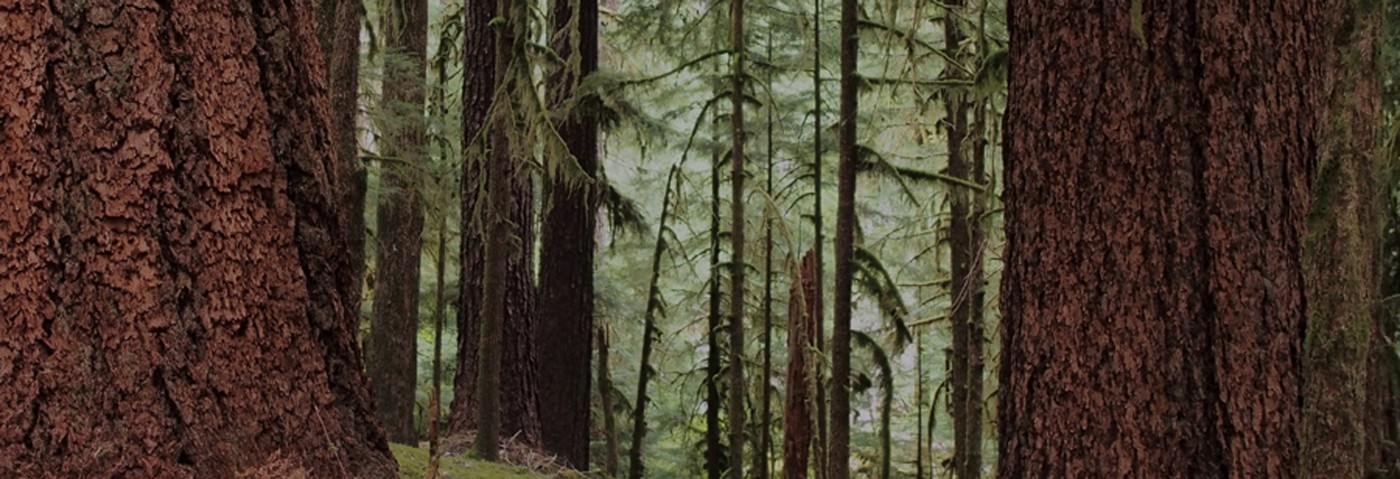

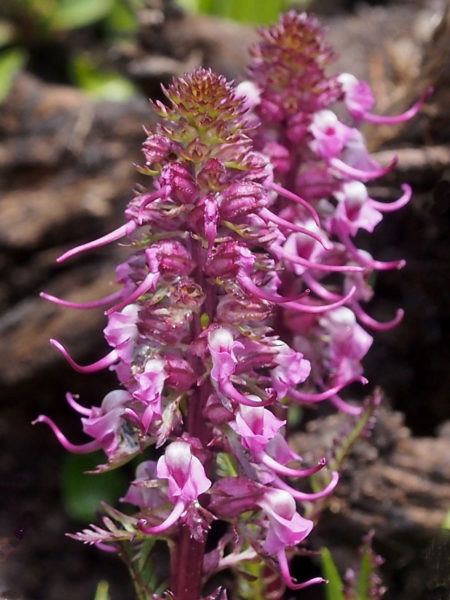
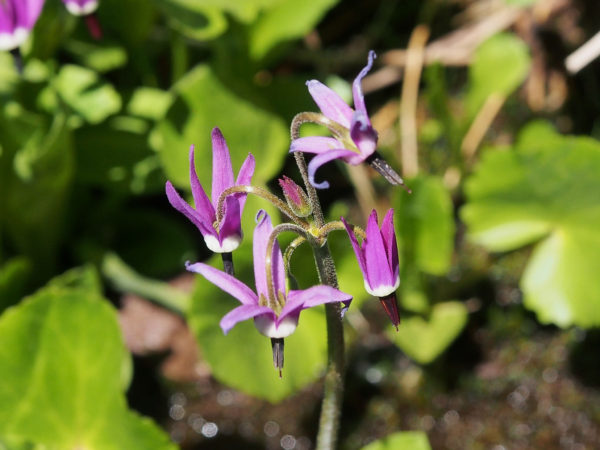
Glad you’re back writing the blog, Johnny!
Thanks, Kit!
What study did the exclusion of pollinators to the paintbrushes? And observations?
Thanks!
W. James Duffield, Pollination ecology of Castilleja in Mount Rainier National Park, The Ohio Journal of Science 72(2): 110-114, 1972. I have also encountered more recent studies done in the Rockies that paint a rather more complex picture, but I stuck with Duffield’s paper because it is local and easy to grasp for explanatory purposes.
Oh wow..! Even the flowers have special ‘tourists’ who travel the continents to serve our ‘mother mountain’..!
Wonderful Johnny